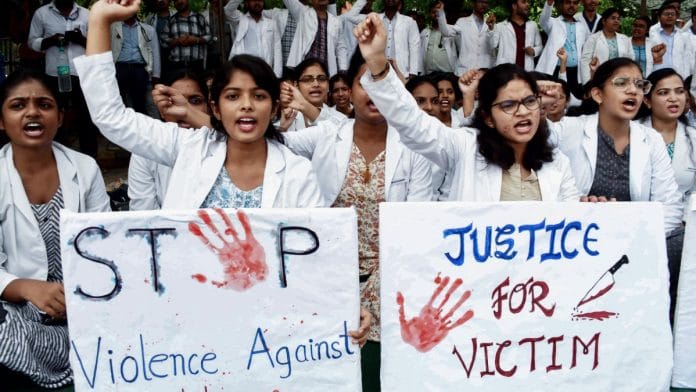Thank you dear subscribers, we are overwhelmed with your response.
Your Turn is a unique section from ThePrint featuring points of view from its subscribers. If you are a subscriber, have a point of view, please send it to us. If not, do subscribe here: https://theprint.in/subscribe/
The news of horrific crimes against women in Kolkata, especially in educational institutions of late has caught everyone’s attention. During my childhood, a visit to my grand -parents at Tollygunge in Calcutta was a yearly ritual. The metropolis was a far cry from the small army garrisons where we were mostly stationed. These were often located a few miles away, even from the nearest town. In contrast, Calcutta was huge! The familiar sight of the iconic Howrah bridge, Victoria memorial, the old LIC building and numerous Gothic, Victorian and Indo- Saracenic structures were awe-inspiring. Giant billboards like that of the famous “Murphy baby” (of 1970s) at one end of Howrah bridge are still indelibly etched in my mind. The sight of busy streets with taxis, cars, buses and trams – all honking without any reason, was oddly amusing. The tram bells were the only welcome chime in this cacophony.
Calcutta (now Kolkata) seemed to offer everything that was in vogue those days. We had our shopping lists ready for New Market – denims, corduroys, fashionable sandals for little girls, fancy hairclips, hairbands and so much more. After our vacation, I would proudly flaunt them at birthday parties. The fancy sandals were the most admired possessions as black leather school shoes (Mary Jane style) usually doubled up as birthday party footwear back then.
In my earliest memories of Kolkata, women were seen in large proportions in public spaces, be it for work, running errands or for leisure. So, travelling by tram from Tollygunge to Esplanade accompanied only by young cousins appeared to be perfectly safe.
In the mid -1980s, I was a teenager when I came to Kolkata as a permanent resident. I had been across the length and breadth of India as an army officer’s daughter. Having had a cosmopolitan upbringing, the prospect of settling down in one place with perceived unidimensional lifestyle didn’t seem appealing to me at first. However, after unlearning a few prejudices, the city grew on me and I became fond of it. It was heartening to see the common man pro-active and readily coming to the aid of women in uncomfortable situations. Courtesies like offering seats to senior citizens and middle -aged women in public transport were common. One noticed the conductor thumping the door with his fist and shouting “ladies-ladies” to warn the driver to be extra careful even if there was a single lady disembarking from the bus.
It was also routine to see women waiting for buses and trams late in the night. The moral decay of present times certainly was beyond anyone’s imagination then.
Kolkata has always been a pluralistic society. The Bengalis, Marwaris, Biharis, Anglo- Indians, Sindhis, Sikhs, Muslims, Jews and so many others including people of Chinese descent have lent a distinctive character to this vibrant and soulful city. They have all contributed with their diverse values and identities to Kolkata’s cultural heritage. Packing a bite from Nahoum, the famous Jewish bakery in New Market, having a roll from Nizam’s, breakfast at Flury’s, lunch at Mocambo on Park Street or a Chinese treat at Kolkata’s China Town were quite common. Trying out sweets at KC Das and savouring Mughlai parathas at “Anadi Cabin” in Dharamtalla defined the essence of the Kolkata I knew.
Durga puja, Christmas and New year celebrations beckoned the Kolkata diaspora from across the country and the globe. Again, one saw a lot of women partaking in the celebrations late into the night. This is not to say that the city was bereft of crimes against women but fortunately, these incidents were met with strong public outcry, rising above political and social affiliations.
Educational institutions, colleges and universities were revered citadels of learning, progress and evolution. Colleges, in those days too, had student unions with political leanings but the students who chose to stay dissociated, were allowed to do so. The management, faculty members and students never lost sight of the primary reason for which they were there.
It has been close to thirty years that I have moved away from Kolkata. My window to the city is now through the news on TV or newspapers. Heartbreaking it is to note that the impression of Kolkata as being a safe and progressive city for women is fast becoming a sentiment of the past.
I wonder why! What has changed? Is it the incel culture among the young men today or is it a drastic degradation of morals, values and a complete lack of introspection and education? Or is it simply warped masculinity fueled by overexposure to the dark side of the online world?
These pieces are being published as they have been received – they have not been edited/fact-checked by ThePrint.


